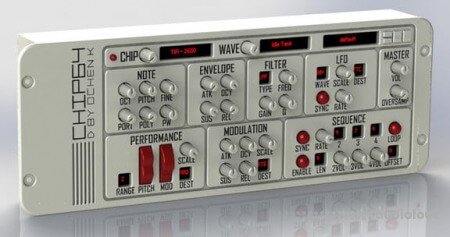
Chip64 brings the sound chips from vintage computers and video game consoles to the Reason rack. Chip64 includes mathematical modeling of 5 chips: the TIA used in the Atari 2600, the SID chip used in the Commodore 64, the TA0x series used in the NES and Gameboy, the Vic-I used in the Vic 20, and the SN76489 chip used in the ColecoVision and Sega consoles. With an on-board sequencer, as well as a multi-mode filter, LFO, modulation envelope, and more, Chip64 brings true chip emulation to your rack.
Chip64 is a synth that emulates sound chips from early computers and video game consoles. It does not use samples, but rather mathematically models the entire dynamic range of each wave of each chip. This makes Chip64 fast, accurate, and light on DSP.
Five chips included:
- TIA (used in the Atari 2600)
- SID (used in the Commodore 64)
- TA0x series (used in the NES and Gameboy)
- Vic-I (used in the Vic 20)
- SN76489 (used in the ColecoVision and Sega consoles)
Onboard sequencer:
Chip64 comes with its own on-board sequencer, allowing free-running and tempo-synced sequences of up to 4 notes, looped or one-shot. Additionally, each iteration of the loop can be offset by any number of half-steps up to a full octave up or down.
Aggressive filters:
There's an extremely aggressive multi-mode bi-quad filter included, featuring low pass, high pass, band pass, notch, parametric, low shelf, and high shelf modes. The frequency range for each filter is the entire audible range, and the slope goes from 0 to infinity, allowing for everything from surgical cuts and boosts to gentle effects over the entire frequency range. Each filter can also be overdriven leading to self-oscillation.
Other features:
- Notes can be tuned up and down four octaves (nine octaves total), up and down 12 notes (25 notes total), and up and down 100 cents
- Can be either monophonic or polyphonic, with voice counts from 1 to 12
- Variable portamento
- Pulse width (used with the SID pulse wave)
- ADSR envelope with attack, decay, and release times from 0 to 2 seconds
- LFO with seven waveforms (sine, triangle, ramp, reverse ramp, square, exponential) that can be sent to eight different destinations (pitch, volume, filter frequency, filter gain, filter Q, sequence offset, sequence rate, pulse width)
- LFO can be free-running or tempo synced and can scale from off to full -1 to 1 amplitude
- Pitch bend with range from 1 to 12 steps
- Modulation wheel with scale from -100% to 100% that can be sent to seven destinations (filter frequency, filter gain, filter Q, LFO rate, LFO scale, pulse width, sequence rate)
- Modulation envelope with scale from -100% to 100% that can be sent to nine destinations (pitch, filter frequency, filter gain, filter Q, volume, LFO rate, LFO scale, pulse width, sequence rate)
- Master volume
- Selectable oversample setting (off, low, high)
- Stereo audio in
- CV connections for key/midi gate and note out
- CV connections for sequence gate and note out
- CV connections for LFO and Modulation envelope out
- CV connections for gate and note in
- CV connection for envelope in
- Four generic CV ins that can be sent to 12 destinations (pitch, volume, filter frequency, filter gain, filter Q, sequence offset, LFO rate, LFO scale, pitch bend wheel, mod wheel, pulse width, sequence rate)
Home page
DOWNLOAD
